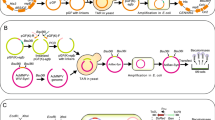Summary
The green fluorescent protein (GFP) from the jellyfishAequorea victoria has attracted widespread interest since it was demonstrated to be fluorescent in vivo when expressed in other organisms. In order to investigate papillomavirus life cycle which hampered by the unavailability of conventional cell culture system, we constructed a chimeric bovine papillomavirus (BPV) type 1 virus-like particles (VLPs) containing GFP. It was found that fluorescent VLPs could be assembled from L2 protein in which GFP is inserted into the N-terminal region of L2 (aa 88). The fluorescent VLPs could also be assembled from a GFP/L2 fusion protein in which part of the L2 sequence had been deleted.In vitro, fluorescent VLPs could bind to CV-1 cells, and this VLP/cell interaction could be analyzed by FACS assay. These results demonstrated that GFP could incorporate into BPVl VLPs without disruption of the VLP structure. Fluorescent VLPs might be a useful tool for study of papillomavirus virus/cell interaction.
Similar content being viewed by others
References
Zhou J, Sun X Y, Stenzel D Jet al. Expression of vaccinia recombinant HPV 16 L1 and L2 ORF proteins in epithelial cells is sufficient for assembly of HPV virion-like particles. Virology, 1991, 185:251
Qi Y M, Peng S W, Hengst Ket al. Epithelial cells display separate receptors for papillomavirus VLPs and for soluble L1 capsid protein. Virology, 1996, 216:35
Schiller J T, Roden R B. Papillomavirus-like particles. Papillomavirus Report, 1995, 6:121
Liu W J, Gissmann L, Sun X Yet al. Sequence close to the N-terminus of L2 protein is displayed on the surface of bovine papillomavirus type 1 virions. Virology, 1997, 227:474
Cubitt A B, Heim R, Adams SRet al. Understanding, improving and using green fluorescent proteins. Trends Biochem Sci, 1995, 20, 448
Chalfie M, Tu Y, Euskirchen Get al. Green fluorescent protein as a marker for gene expression. Science, 1994, 263, 802
Wang S, Hazelrigg T. Implications for bcd mRNA localization from spatial distribution of exu protein in Drosophila oogenesis. Nature, 1994, 369:400
Peng S W, Frazer I H, Fernando G Jet al. Papillomavirus virus-like particles can deliver defined CTL epitopes to the MHC class I pathway. Virology, 1998, 240:147
Sun X Y, Frazer I, Muller Met al. Sequences required for the nuclear targeting and accumulation of human papillomavirus type 6B L2 protein. Virology, 1995, 213:321
Zhou J, Sun X Y, Louis Ket al. Interaction of human papillomavirus (HPV) type 16 capsid proteins with HPV DNA requires an intact L2 N-terminal sequence. J Virol, 1994, 68:619
Heim R, Cubitt A B, Tsien R Y. Improved green fluorescence [letter]. Nature, 1995, 373, 663
Author information
Authors and Affiliations
Rights and permissions
About this article
Cite this article
Shiwen, P., Jian, Z. & Frazer, I.H. Construction and production of fluorescent papillomavirus-like particles. Current Medical Science 19, 170–174 (1999). https://doi.org/10.1007/BF02887727
Received:
Published:
Issue Date:
DOI: https://doi.org/10.1007/BF02887727




